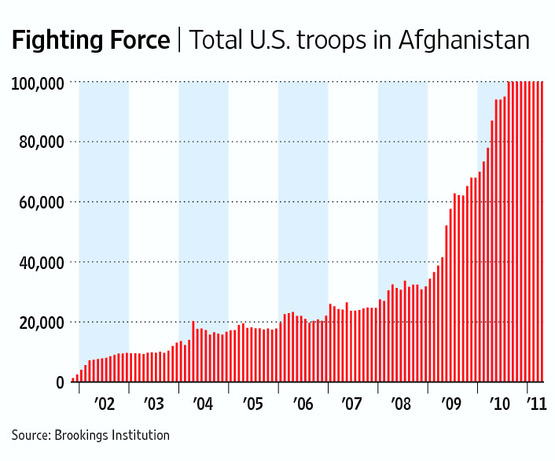http://online.wsj.com/article/SB10001424052748704473104576293380970409242.html
APRIL 30, 2011
Pentagon Claims Progress Against Afghan Taliban
By JULIAN E. BARNES A new Pentagon report provides the military's most positive assessment of the Afghanistan war in years, arguing the U.S. strategy to send a surge of troops to the country has achieved significant security progress and "broadly arrested the momentum" of the Taliban. The report comes as the military is trying to make its case to the White House to begin troop withdrawals only slowly, keeping high numbers in Afghanistan in order to maintain pressure on Taliban fighters. The level of violence in Afghanistan remains high. The number of weekly attacks hit a new peak of more than 1,600 at the end of the fighting season in September. The number of attacks from November 2010 to March 2011, the period of time covered by the new report, was significantly higher than a corresponding period a year before, although violence usually declines in the winter. Critics have cited the increased violence and continued high casualty rates among U.S. and Afghan security forces as evidence that the U.S. surge hasn't made as much progress as the military contends. The report makes the case for progress based on the U.S. operations to disrupt insurgents that have contributed to "a loss of Taliban influence in key areas." The report argues that complex attacks are down, reflecting a decline in Taliban capabilities and "eroding morale" within the insurgency. Previous Pentagon reports have been more downbeat, assessing the security situation as deteriorating. Maj. Gen. Richard Mills, who recently left Afghanistan after a year commanding the Marine Expeditionary Force in Helmand and Nimroz provinces, said in an interview Friday that he had seen positive changes during his tenure. Major trouble spots still remain in northern Helmand, he acknowledged. But in areas where coalition forces have had enough time on the ground, such as Garmsir and Marjah, the initial focus of the last year's surge, Gen. Mills said people in Afghanistan were now willingly opening businesses, sending their children to school, and engaging with the growing Afghan government presence. American forces in Afghanistan are slated to begin drawing down in July, transferring security duties to Afghan troops as part of a plan that calls for most foreign combat soldiers to leave by the end of 2014. The new report notes similar challenges the military has long cited, including a lack of specialized trainers for the Afghan military and problems building up government institutions and rule of law in areas cleared of insurgents. Havens for militants in Pakistan remained a problem as well. Despite the optimistic tone of the report, the Department of Defense believes Taliban militants will continue to carry out attacks at a high level. The report, which is required by Congress, cost $344,259 to produce. Defense Secretary Robert Gates has mandated the Pentagon disclose the production costs of every report written by the department. --Matthew Rosenberg contributed to this article.
